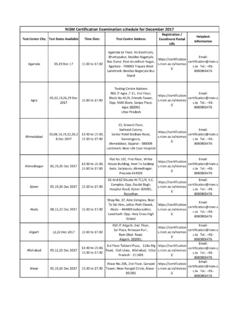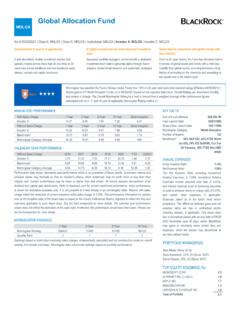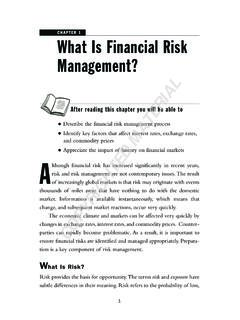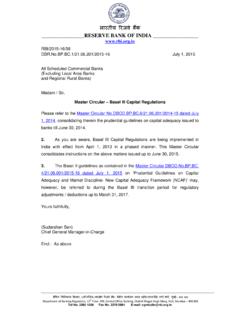Transcription of Equity Derivatives - National Institute of Securities ...
1 National Institute OF Securities MARKETS. SCHOOL FOR Securities EDUCATION. Equity Derivatives . Frequently Asked Questions (FAQs). Authors: NISM PGDM 2019-21 Batch Students: Abhilash Rathod Akash Sherry Akhilesh Krishnan Devansh Sharma Jyotsna Gupta Malaya Mohapatra Prahlad Arora Rajesh Gouda Rujuta Tamhankar Shreya Iyer Shubham Gurtu Vansh Agarwal Faculty Guide: Ritesh Nandwani, Program Director, PGDM, NISM. Table of Contents Sr. Question Topic Page No No. Numbers 1 Introduction to Derivatives 1-16 2. 2 Understanding Futures & Forwards 17-42 9. 3 Understanding Options 43-66 20. 4 Option Properties 66-90 29. 5 Options Pricing & Valuation 91-95 39.
2 6 Derivatives Applications 96-125 44. 7 Options Trading Strategies 126-271 53. 8 Risks involved in Derivatives trading 272-282 86. Trading, Margin requirements &. 9 283-329 90. Position Limits in India 10 Clearing & Settlement in India 330-345 105. Annexures : Key Statistics & Trends - 113. 1|P a g e I. INTRODUCTION TO Derivatives . 1. What are Derivatives ? Ans. A Derivative is a financial instrument whose value is derived from the value of an underlying asset. The underlying asset can be Equity shares or index, precious metals, commodities, currencies, interest rates etc. A derivative instrument does not have any independent value. Its value is always dependent on the underlying assets.
3 Derivatives can be used either to minimize risk (hedging) or assume risk with the expectation of some positive pay-off or reward (speculation). 2. What are some common types of Derivatives ? Ans. The following are some common types of Derivatives : a) Forwards b) Futures c) Options d) Swaps 3. What is Forward? A forward is a contractual agreement between two parties to buy/sell an underlying asset at a future date for a particular price that is pre decided on the date of contract. Both the contracting parties are committed and are obliged to honour the transaction irrespective of price of the underlying asset at the time of delivery. Since forwards are negotiated between two parties, the terms and conditions of contracts are customized.
4 Forwards contracts are negotiated bilaterally between two parties in Over the counter (OTC) markets and are not traded on the Stock Exchange. 4. What are Futures? A futures contract is similar to a forward, except that the deal is made through an organized and regulated stock exchange rather than being negotiated directly between two parties. Forwards and Futures contracts are discussed in detail in Part II of the document 2|P a g e 5. What are Options? An Option is a contract that gives the right, but not an obligation, to buy or sell the underlying on or before a stated date and at a stated price. While buyer of option pays the premium and buys the right so write off the contract at any time whereas the writer/seller of option receives the premium with an obligation to sell/ buy the underlying asset, if the buyer exercises his right.
5 6. What are the types of Options? There are two types of Options, Call Options and Put Options A call option gives, the holder, the right to buy a specified quantity of the underlying asset at the strike price on a predetermined date. A put option, on the other hand, gives, the holder, the right to buy a specified quantity of the underlying asset at the strike price on a predetermined date. Options are discussed in detail in Part III of the document 7. What are various underlying asset classes on which Derivatives contracts exist? Ans. The following are some popular underlying asset classes on which Derivatives contracts exist: Equity Commodities Interest rates Currencies Popular Derivatives Contracts 3|P a g e 8.
6 What are major segments on which Derivatives are traded? Ans. i) Exchange Traded Markets - Exchange-traded Market is platform where the contracts are standardized, traded on organized exchanges with prices determined by the interaction of buyers and sellers through anonymous auction platform. A. clearing corporation, guarantees contract performance (settlement of transactions). ii) Over the Counter (OTC markets) - Over the Counter (OTC) derivative contracts are signed between the two parties without going through the platform of a stock exchange or any other intermediary. OTC is the term used to refer stocks that trade through a separate dealer.
7 These are well known as unlisted stocks where the Securities are traded by broker-dealers through over the counter negotiations. 9. What is the history of evolution of Global Derivatives markets? 4|P a g e 10. How big the Derivatives markets are globally? The global financial Derivatives markets are estimated to be over 4,500 trillion dollars, for the year 2019, based on the yearly turnover on notional value basis. (Source: Bank of International Settlements and World Federation of Exchanges). Annexure 1 of the document contains key statistics with regard to the size and growth of global financial Derivatives markets. 11. How big are Equity Derivatives markets in India?
8 Ans. The total turnover in exchange traded Equity Derivatives markets stand at over Rs. 3,400 lakh crores, on the basis of Notional Value of the contracts, for the 2019-20. (Source: SEBI Annual Report). Annexure 2 of the document contains key statistics with regard to the size and growth of Indian Equity Derivatives markets. 12. How have the Equity Derivatives grown in India over last 15 years? Between year x and year Y. Ans. Over the last 15 years, the total turnover in exchange traded Equity Derivatives markets has grown exponentially at a CAGR of 33% from Rs. 48 lakh crores in 2005-06 to Rs. 3,450 lakh crores in 2019-20. Annexure 2 of the document contains key statistics with regard to the trend of Indian Equity Derivatives markets.
9 5|P a g e 13. How does the size of Exchange traded Equity Derivatives compare with the size in the Equity Cash market? How has it changed over past few years? Ans. For 2019-20, the yearly turnover on exchanges in Equity Derivatives markets (based on notional value) is approximately 35 times the yearly turnover in Equity cash markets. The trend has been more or less same for last few years. The Equity Derivatives market and Equity cash market has grown with a CAGR growth of and respectively since 2013-14 till 2019-20. The data with regard to same is captured in Annexure 2 of the document. 14. What is the significance and impact of Derivatives markets?
10 Ans. Like other segments of Financial Market, Derivatives Market serves following specific functions: Derivatives market helps in improving price discovery of the underlying based on actual valuations and expectations. Derivatives market helps in transfer of various risks from those who are exposed to risk but have low risk appetite to participants with high risk appetite. For example, hedgers want to give away the price risk of the underlying where as traders are willing to take this risk. Derivatives market helps shift of speculative trades from unorganized market to organized market. Risk management mechanism and surveillance of activities of various participants in organized space provide stability to the financial system.









